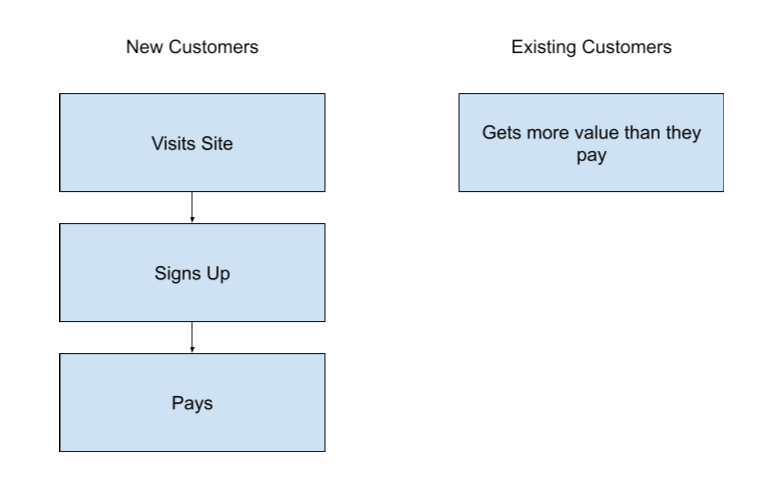Building A Content Factory

We should build a content factor. There are effectively two activities in company building (at the beginning). There's building and there's selling. If you're not building, then you're selling. If you're not building or selling, then you don't work here.
Here's a flow chart because why not:

Let's chat engineering first.
Do as little as possible. If you buy well, you may need to invest a lot in the first 3 months of ownership, but the goal is to get it on a path of bug fixes and incremental features as quickly as possible. Then stack rank bugs / features across the portfolio and start assigning tickets. Avoid rebuilding from scratch. I'm a (tech old) developer so maybe this is more logical for me than for you. Maybe I'll write about it.
Ok great. Now that engineering is covered, let's talk about growth via another flow chart.

Sweet... so we're buying existing businesses. There should be some numbers along the arrows on the left hand side of this chart. Signups / Visits. Paying / Signups.
The thing you're buying should have some traffic. That traffic will be paid or organic. Either is okay. I try to have at least one channel that is working. Even if it's paid, I'll still count it. I just want something I can buy and not have to guess about growth. I firmly believe you really only need one channel to work for you to get to a decent MRR. This is particularly true for the size of the companies we buy. They're small. One channel can easily mean 2x-ing or 4x-ing the business.
If we're buying something with a decent amount of organic traffic, and that organic traffic is driving growth, then we need to keep pushing out content similar to what is already working. Hence we need a content factory.
Another consideration as we chose which shared services to build internally, which to outsource, and which to avoid, this actually starts to box in what we buy. By that i mean we no longer buy anything and everything. We start to have a smaller buy box. Stuff that fits into our model well. And if we build this content factory, we'd prefer buying companies who could use it.
We've all but settled on buying product led growth companies only. One shared service we're going to avoid for the time being is building out a shared sales team. At some point this might make sense but for now it doesn't. Danny is already amazing at it and can and does fill in for that role when needed. But in the future we're going to index more heavily on things that do not require a phone call / meeting to get people to buy. Of course larger customers will want to speak with someone, that's fine, Danny or I can and do handle those already, we just don't need a shared service team yet to handle the volume.
So what does a content factory look like? Let's start with another flowchart, it's that kind of week.

Sheet.best and screenshotapi.net both need technical blog posts. Not exclusively, but by majority they do. Inlytics.io needs non-technical content. Finding technical content writers is tough. And they're surprisingly expensive.
Objective:
- One blog post per week per company
- All in costs from idea to post are no more than $100. Add $50 if they make a video too.
- All in partner time for dealing with content is < 1 hour per company
- Empirical evidence the content is driving high quality traffic and increasing rankings.
How
I've hustled developers on twitter and dev.to to ask if they'd write articles. Sometimes they say yes and for a while we had a small pool of writers, but the content wasn't that good and it was around $150 to $200 per post. A little expensive.
This time around we're going to try and focus on finding a non-technical writer to write about the products and or use cases but not necessarily writing developer tutorials. We're going to focus on search rankings and of course sharing out through social.
We'll start with outsourced writers. Can we get decent content? Can we get it consistently? Can we do this without it taking up a bunch of our time? Will it be cost effective?
The part I will spend a lot of my time on is figuring out how to measure this stuff. To date, we've been pretty bad at getting consistent measurements across companies. Truthfully I think a lot of companies don't really know their metrics until around a Series A. For them it doesn't really matter, they can just focus on the growth numbers (historically) and punt on a whole host of other stuff. We're focused on profitability, so we're going to have a slightly different set of metrics, mostly around dollars in and dollars out.
Getting this right and executing on this consistently will put us in a great spot to continue buying PLG companies and growing them. Regrettably, we're probably going to have to build our own tool to get these measurements just the way I want them. I've built an MVP that is a sketch of this idea. It's cool, but not quite useful yet. Once we get it right though, I think it'll be a secret weapon. Perhaps we'll launch it as a product one day!
✌️,
Andrew





